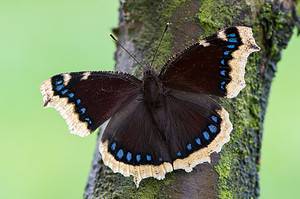Butterflies are often presented as a natural reminder of how fleeting and fragile beauty can be. Their petite and delicate bodies are accompanied by often gorgeous wing patterns, and the transition from a hungry caterpillar into a gorgeous butterfly is like the story of the ugly duckling made flesh. The average adult butterfly’s lifespan is only a few weeks, and it only lends this perception more poignancy. But our general perception of these unique insects is complicated by the facts.
There are over 17,000 species spread across every continent apart from Antarctica, and many species have had to adopt unusual and bizarre behaviors to adapt to the harsh facts of their unique ecosystems. There are carnivorous butterflies that prey on aphids and another species that tricks ants into hatching and raising their young. Here are eight of the most unique butterflies. Whether colorful, rare, endangered, or just plain bizarre, each of these types of butterfly reveals some fascinating facts about natural selection.
#8: Queen Alexandra’s Birdwing — The World’s Largest Butterfly

©Ashley Swanson/Shutterstock.com
This large butterfly species native to Papua New Guinea was named after Danish royalty, so it makes sense that the females are the largest members of the species. Their wingspan can reach 11 inches from tip to tip, and males are slightly smaller than females overall. Males of the species also sport a colorful blue and green body that’s a stark contrast to the gray and cream of female members of the species. While this is a common tactic to distract predators away from females, few animals pose a direct threat to Queen Alexandra’s Birdwings.
Unfortunately, they face a greater threat in the form of deforestation from the palm oil industry and an avid interest from black market dealers. Now critically endangered, it’s believed that their population has been reduced to four small communities throughout only 40 square miles.
#7: Western Pygmy Blue Butterfly — The World’s Smallest Butterfly

©dhhanu/Shutterstock.com
While the Queen Alexandra’s Birdwing towers over most of its brethren with its nearly foot-long span, it’s an especially sharp counterpoint to the world’s smallest butterfly. The Western Pygmy Blue butterfly is a unique butterfly that often measures less than half an inch. Despite their name, these aren’t colorful birds and instead primarily sport brown coats that make these most unique butterflies even harder to spot. But flying under the radar has presumably allowed them to become one of the most prolific butterfly species in the Americas.
The biggest populations are located in Mexico and Central America, where more consistently warm climates provide them with plenty of flowers to feed on. But the United States is also home to a healthy population of Western Pygmy Blues that extends as far north as Oregon. They even adapt well when introduced to new climates and have extended their reach to Hawaii and Saudi Arabia.
#6: Brimstone Butterfly — The World’s Longest Lived Butterfly

©Ian Grainger/Shutterstock.com
The mayfly is the animal species with the shortest lifespan, and they’ll die within a day of being born. On the other end of the spectrum is the animal with the longest lifespan — the Greenland shark and its life expectancy of up to 300 years. The Brimstone Butterfly has the longest life expectancy of any butterfly, but its upper range of 13 months places it much closer to the mayfly than the Greenland shark. This unique butterfly can be identified by their distinctly green and leaf-shaped wings, and the six subspecies can be found throughout Europe, Asia, and Africa. The short lifespan of most butterflies is influenced by a lack of suitable flowers to feed on in colder seasons, but brimstone butterflies overcome this by occupying tropical climates when possible and otherwise hibernating through the winter.
#5: Spring Azure — The Butterfly With the Shortest Life Expectancy
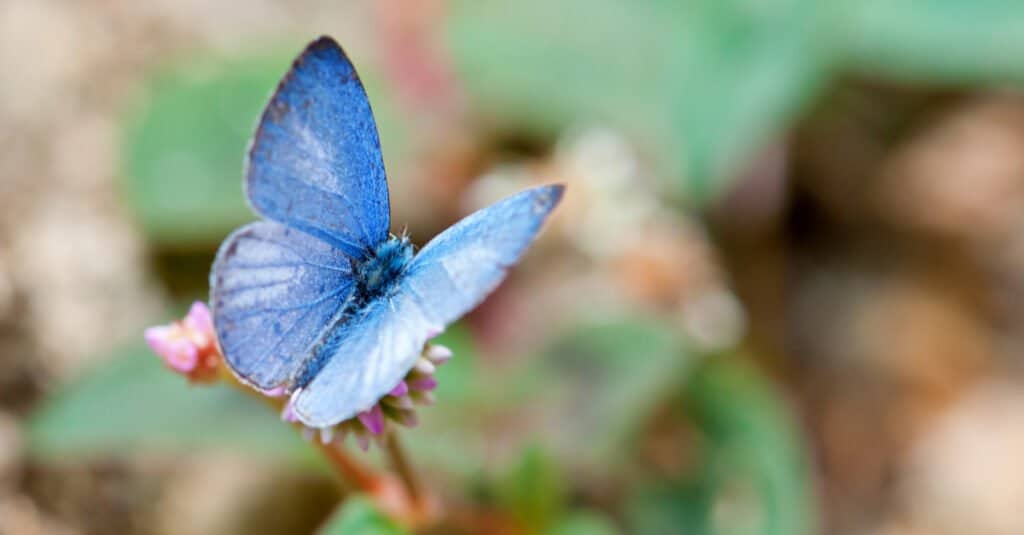
©johannviloria/Shutterstock.com
With a wingspan of an inch, the Spring Azure doesn’t quite beat out the Western Pygmy Blue for the position of the smallest species on our list of the most unique butterflies, but it’s both one of the earliest of the North American butterflies to awaken in the spring and one of the first to disappear. Unfortunately, the latter characteristic comes down to the fact that adults die only a few days after emerging from the chrysalis. While this might seem like it would affect their long-term success as a species, Spring Azure butterflies manage to make it through the colder snap of the year by entering chrysalis as the weather begins to get colder and not emerging as fully-formed butterflies until the time of the first thaw. Far from rare, these insects span from Canada in the north to Colombia in the south.
#4: Painted Lady — The Farthest Migration of Any Species
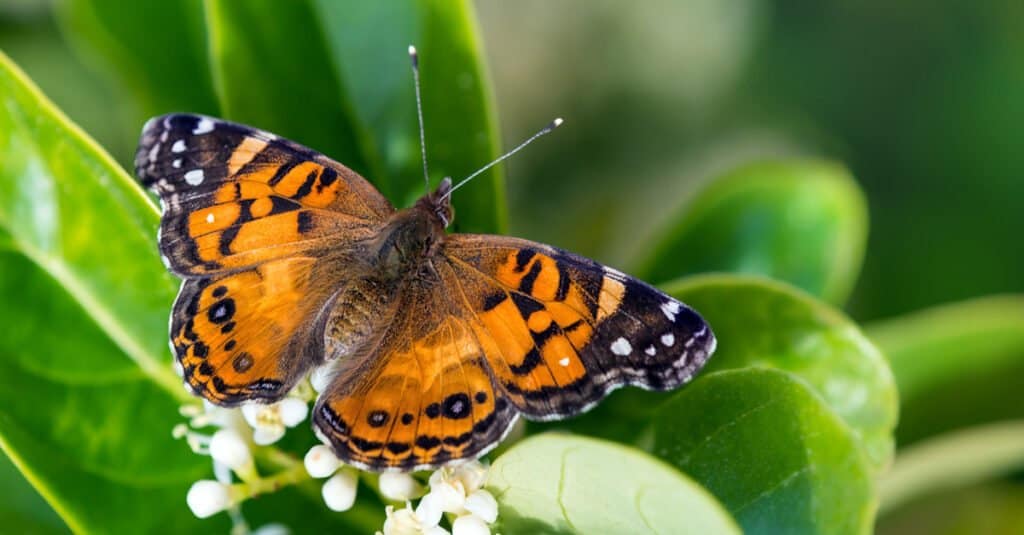
©iStock.com/leekris
While the Spring Azure spring survives the cold bite of winter by essentially entering into stasis, other butterfly species migrate to warmer climates. But the Painted Lady butterfly bucks conventions by both boasting the longest migration route and refusing to stick to seasonal flight routes. While scientists aren’t quite sure what dictates their migration patterns, it’s believed that precipitation and storm patterns may have a part to play. The path takes them from Canada down to Mexico. It’s a trip that spans roughly 8,000 miles, and the typical journey will see six generations of butterflies come and go. Painted Lady butterflies can manage to fly so far because they’re generalists known to feed on around 300 different types of flowers. They also have the unusual ability — which they share with the monarch butterfly — to store toxic chemicals from the flowers they eat in their blood, making them unpalatable to many predators.
#3: Zebra Longwing — Butterflies That Can Feed on Pollen
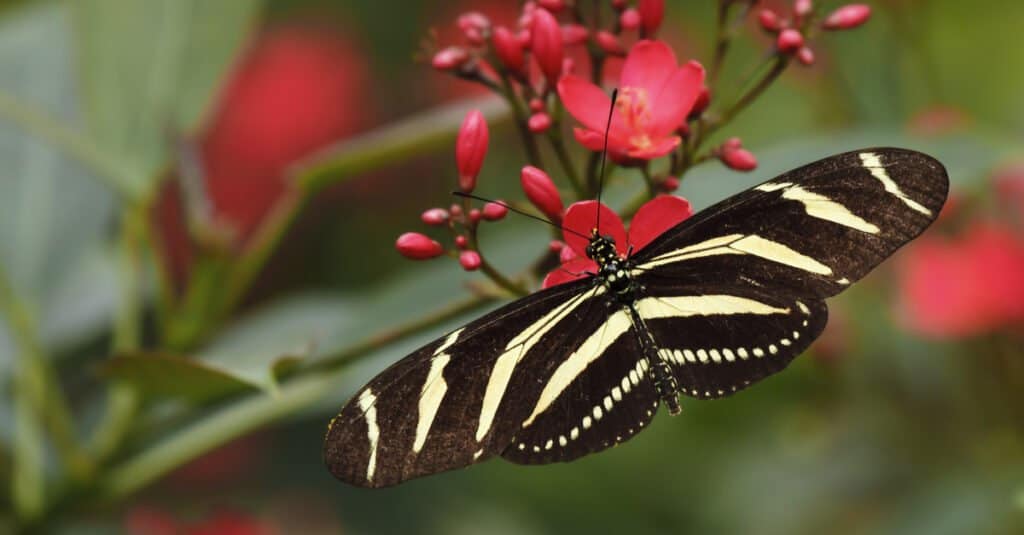
©schaef71/Shutterstock.com
Found mostly in Mexico and Central America but also scattered communities as far north as Texas and Florida, the Zebra Longwing’s uniquely striped wings are of secondary interest to their unique dietary habits. While most types of butterflies can only drink nectar through their long straw-like proboscises, zebra longwings can break down and absorb pollen. That’s a big deal because it allows them to get more nutrition out of each plant, but pollen is also significant for its high level of proteins. Ironically, butterflies spend their entire time as caterpillars gathering protein for their metamorphosis only to adopt a diet that’s almost absent in protein once they complete their metamorphosis into adulthood. This allows them to live for up to six months and lay multiple eggs in a life cycle.
#2: Harvester Butterfly — The Butterfly That’s Also a Carnivore
The Harvester butterfly isn’t endangered, but it is rare insofar as it’s the only butterfly in North America known to be fully carnivorous during the caterpillar phase of its life cycle. More specifically, harvester caterpillars are specialized carnivores who feed almost exclusively on woolly aphids. Despite aphids being significantly larger than most young caterpillars and being in a protective symbiotic relationship with indigenous ants, these creatures have developed a bizarre adaptation that allows them to chemically mask themselves from detection by these dangerous ants and employ their silk webbing to immobilize aphids that they then feed on.
Adult harvester butterflies aren’t carnivores, but they continue to have an unusual diet that’s predicated on the presence of aphids. Their short proboscises make dining on flower pollen difficult, and they instead feed off a combination of aphid honeydew, dung, and mud.
#1: Alcon Blue — The Butterfly That Lets Ants Raise Its Young
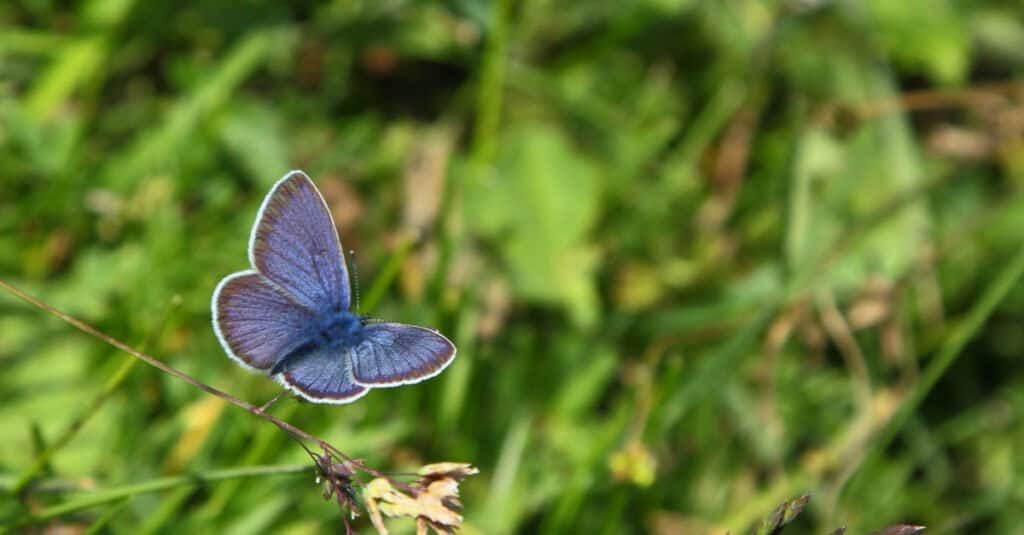
©Gergo Nagy/Shutterstock.com
If the relationship between ants and the Harvester butterfly can be identified as directly antagonistic, the relationship between Alcon Blue and ants is far more complex. Employing a similar strategy to the cuckoo bird, they go through the first three stages of molting on the flower on which they’re laid falls to the ground. Once they come in contact with the indigenous red myrmica ant, they’ll instinctively secrete a sweet substance that the ant can eat and also gives off chemicals that make ants mistake them for their own young.
For a period of up to two years, these pupae will be fed by unsuspecting ants that neglect their own young for the sake of the parasitic intruder. They can grow up to 100 times their initial size during this process. And while ants recognize the intruder once it hatches, the adult Alcon blue’s scaly wings protect it from attack. Despite this ingenious approach to maturation, the Alcon Blue continues to be an endangered species and one of the most unique butterflies.
Up Next
- 10 Poisonous Butterflies Butterflies are amongst the most harmless creatures, so how do they defend themselves? By making other animals regret preying on them. Check out this article to see how they manage this.
- Butterfly Predators: What Eats Butterfly? We see beautiful, delicate, fairy-like creatures. Some animals see dinner. Click this link to find out what is able to eat a butterfly.
- 10 Incredible Butterfly Facts Not just a pretty face. Butterflies are an important part of the ecosystem. Check out some of the more amazing things that they do here.
The photo featured at the top of this post is © Ricardo Ayres/Shutterstock.com
Thank you for reading! Have some feedback for us? Contact the AZ Animals editorial team.




